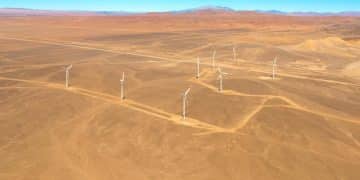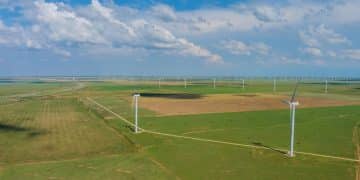US Renewable Energy: Latest Tech Innovations Unveiled

The latest innovations in US renewable energy technology are rapidly advancing, encompassing breakthroughs in solar efficiency, enhanced battery storage, next-generation wind turbines, and emerging geothermal and sustainable biofuel solutions, all aiming for a more resilient and decarbonized energy grid.
As the world grapples with climate change and the urgent need for sustainable practices, the United States stands at the forefront of renewable energy innovation. This dynamic sector is witnessing unprecedented growth, driven by technological breakthroughs, economic incentives, and a growing public demand for cleaner power. Exploring what are the latest innovations in renewable energy technology in the US reveals a landscape brimming with promising advancements, reshaping how energy is generated, stored, and distributed across the nation.
Revolutionizing Solar Power: Beyond Traditional Panels
Solar energy, a cornerstone of renewable power, continues to evolve at a remarkable pace. The pursuit of higher efficiency, lower costs, and broader applicability is driving significant innovation in the US. While conventional silicon-based photovoltaic (PV) panels remain prevalent, research and development are pushing boundaries into new materials and designs.
Perovskite Solar Cells: The Next Frontier?
Perovskite materials represent one of the most exciting developments in solar technology. These compounds have demonstrated impressive efficiency gains in laboratory settings, rivaling silicon, and offer the potential for lower manufacturing costs and flexibility. The US has several research institutions and startups focused on scaling up perovskite production.
- High Efficiency: Perovskites can absorb light across a broader spectrum and have achieved efficiencies over 25% in lab conditions.
- Lower Manufacturing Cost: Their potential for solution-based processing could drastically reduce production expenses.
- Flexibility: Perovskites can be printed onto flexible substrates, opening doors for integration into windows, façades, and even wearable electronics.
- Tandem Cells: Combining perovskite layers with traditional silicon offers the potential to exceed the theoretical efficiency limits of silicon alone.
Beyond perovskites, advancements in transparent solar cells, which can be integrated into windows without blocking views, and organic photovoltaics, offering lightweight and flexible solutions, are also gaining traction. These innovations are not just theoretical; they are moving from university labs into pilot projects, promising to transform urban landscapes and energy infrastructure.
Another area of intense focus is balance-of-system costs. Innovations in mounting structures, inverter technology, and grid integration are crucial for making solar power more competitive. Smart inverters, for instance, can communicate with the grid, providing ancillary services like voltage regulation and frequency support, which improve grid stability and the integration of intermittent renewables.
The convergence of artificial intelligence (AI) and solar deployment is also noteworthy. AI algorithms are being used for predictive maintenance, optimizing panel orientation, and forecasting solar output with greater accuracy. This level of sophistication allows grid operators to better anticipate energy supply, thereby enhancing reliability and reducing the need for fossil fuel backups.
Furthermore, bifacial solar panels, which generate electricity from both sides by capturing direct sunlight on the front and reflected light on the rear, are gaining market share. This design allows for higher energy yield per panel, particularly in environments with highly reflective surfaces like sand, snow, or light-colored rooftops. The US is a significant market for these panels, recognizing their potential to maximize output from limited land area.
Lastly, solar tracking systems continue to improve, with single-axis and dual-axis trackers becoming more sophisticated and cost-effective. These systems physically move solar panels to follow the sun’s path throughout the day, significantly increasing energy capture compared to fixed-tilt installations. The advancements in smart tracking, incorporating weather data and AI, are making these systems even more efficient and responsive to real-time conditions.
The solar sector in the US is clearly not resting on its laurels. From new materials to smart deployment strategies, the push is toward making solar an even more dominant and reliable source of clean energy.
Advanced Energy Storage Solutions: Powering the Grid of Tomorrow
The intermittent nature of renewable energy sources, especially solar and wind, necessitates robust and efficient energy storage solutions. Without effective storage, surplus energy generated during peak production times cannot be utilized during periods of low production or high demand. The US is investing heavily in diverse storage technologies, moving beyond traditional lithium-ion batteries.
Beyond Lithium-Ion: The Rise of Flow and Solid-State Batteries
While lithium-ion batteries dominate the electric vehicle and consumer electronics markets, their scalability and cost for grid-scale storage present challenges. This has spurred innovation in alternatives. Flow batteries, which store energy in liquid electrolyte solutions in external tanks, offer distinct advantages for large-scale, long-duration storage.
- Scalability: Energy capacity can be increased independently of power capacity by simply scaling up the electrolyte tanks.
- Long Lifespan: Less degradation over charge/discharge cycles compared to lithium-ion, making them suitable for long-term grid applications.
- Safety: Many flow battery chemistries use non-flammable materials, enhancing safety for large installations.
Another promising area is solid-state batteries. These batteries replace liquid or gel electrolytes with solid materials, potentially offering higher energy density, faster charging times, and greater safety. While still largely in the research and development phase for large-scale applications, US companies are making significant strides in material science and manufacturing processes to bring these to market.
Beyond electrochemical batteries, mechanical storage methods like pumped-hydro storage and compressed air energy storage (CAES) are also seeing innovations. While pumped-hydro requires specific geographical features, CAES systems are becoming more efficient with advanced turbine designs and energy recovery systems. These are particularly valuable for long-duration bulk energy storage.
Thermal energy storage (TES) is another critical component, especially for concentrating solar power (CSP) plants. Innovations here involve using molten salt or other heat-transfer fluids to store solar thermal energy, allowing CSP plants to generate electricity long after the sun has set. This provides a dispatchable renewable energy option.
Grid-scale battery deployment is accelerating, supported by federal incentives and state mandates. These batteries not only store energy but also provide crucial grid services such as frequency regulation, voltage support, and black start capabilities, enhancing overall grid resilience and reliability. The integration of advanced power electronics and intelligent control systems is key to maximizing the value of these storage assets.
Lastly, the concept of “virtual power plants” (VPPs) is gaining traction. VPPs aggregate distributed energy resources, including rooftop solar, electric vehicles, and residential batteries, allowing them to act as a single, controllable entity for the grid. This distributed approach reduces the need for massive central power plants and offers greater flexibility and resilience, with sophisticated software orchestrating their collective action.

The diverse portfolio of energy storage technologies under development in the US highlights a commitment to overcoming the variability of renewables, paving the way for a more stable and sustainable energy future.
Innovations in Wind Energy: Taller Turbines and Offshore Frontiers
Wind energy has long been a significant contributor to the US renewable energy portfolio, particularly in central states. Recent innovations are focusing on increasing turbine efficiency, opening up new deployment locations, and integrating wind power more seamlessly into the grid.
Larger Turbines, Greater Output
The trend in onshore wind is towards ever-larger turbines with longer blades and taller towers. These “supersized” turbines can capture wind from higher altitudes, where it is stronger and more consistent, leading to significantly increased energy production per turbine. This economies of scale approach reduces the overall cost of wind power.
- Increased Output: Taller turbines access faster, more consistent winds, translating to higher capacity factors.
- Reduced Footprint: Fewer turbines are needed to achieve a given output, reducing land use and environmental impact.
- Advanced Aerodynamics: Innovations in blade design, including flexible blades and those inspired by whale fins, reduce noise and improve performance.
Offshore wind is another major growth area, particularly along the East and West Coasts. The US has immense offshore wind potential, and technological advancements are making these projects more viable. Floating offshore wind platforms, for example, allow turbines to be deployed in deeper waters far from shore, where winds are even stronger and visual impacts are minimized. This technology is crucial for unlocking the potential in areas with steep continental shelves.
Beyond turbine design, innovations in wind energy also encompass predictive maintenance using AI and IoT (Internet of Things) sensors. These technologies monitor turbine health in real-time, anticipate potential failures, and optimize maintenance schedules, reducing downtime and operational costs. Digital twins of wind farms are also being created to simulate performance and optimize operation.
Moreover, the integration of advanced meteorological forecasting with wind farm operations is enhancing grid stability. Precise wind speed predictions allow grid operators to better manage the supply of wind power, reducing the need for rapid adjustments from conventional power plants. This forecasting capability is becoming increasingly sophisticated, incorporating machine learning models.
The development of hybrid projects, combining wind with solar and battery storage, is also a key innovation. These integrated systems can provide a more consistent output profile, mitigating the intermittency challenges of individual renewable sources. This diversified approach improves the overall reliability and dispatchability of renewable energy.
Community engagement and environmental impact mitigation are also areas of innovation. Project developers are increasingly using advanced siting techniques and collaborating with local communities to minimize negative impacts on wildlife, particularly birds and bats, and to ensure projects benefit local economies through job creation and revenue sharing.
Overall, the US wind industry is pushing the boundaries of what’s possible, from massive turbines harnessing powerful offshore winds to intelligent operational systems and diversified energy portfolios.
Geothermal and Advanced Biofuels: Tapping Earth’s Heat and Organic Matter
While often overshadowed by solar and wind, geothermal energy and advanced biofuels are critical components of a diversified renewable energy portfolio. The US is witnessing significant innovations in these areas, aiming to unlock their full potential as reliable, dispatchable power sources.
Enhanced Geothermal Systems (EGS)
Enhanced Geothermal Systems (EGS) are revolutionizing geothermal energy by enabling access to the Earth’s vast heat resources, even in areas without natural hydrothermal reservoirs. EGS involves injecting water into hot, dry rock formations deep underground to create an engineered reservoir, from which heat can be extracted to generate electricity.
- Resource Expansion: EGS significantly expands the geographical viability of geothermal energy beyond traditional hydrothermal areas.
- Baseload Power: Geothermal plants provide continuous, baseload power, complementing intermittent renewables like solar and wind.
- Reduced Water Use: Innovations are focused on closed-loop systems that minimize water consumption, addressing environmental concerns.
Advancements in drilling technologies, seismic imaging, and reservoir engineering are making EGS more economically feasible. Companies and research institutions in the US are exploring techniques once confined to the oil and gas industry to more efficiently access and manage deep geothermal resources.
Advanced Biofuels and Sustainable Aviation Fuels (SAFs)
Traditional biofuels have sometimes faced criticism regarding land use and food security. However, advanced biofuels are designed to mitigate these issues by utilizing non-food feedstocks such as agricultural waste, algae, and dedicated energy crops. The US is a major player in developing these next-generation biofuels.
A significant focus is on Sustainable Aviation Fuels (SAFs). SAFs, which can reduce lifecycle greenhouse gas emissions by up to 80% compared to conventional jet fuel, are crucial for decarbonizing the aviation sector. Technologies for producing SAFs include converting municipal waste, agricultural residues, and even captured carbon dioxide into fuel.
Algae-to-fuel technology is another area of active research. Algae can grow rapidly, absorb CO2, and produce diverse oils suitable for biofuel production without competing for arable land. US researchers are working on bioreactor designs and cultivation methods to make algae biofuel commercially viable.

The development of biorefineries capable of producing multiple products—fuels, chemicals, and materials—from biomass is also gaining traction. This integrated approach, often referred to as a “bioeconomy,” maximizes resource utilization and enhances economic viability. Government incentives and corporate partnerships are accelerating the commercialization of these advanced biofuel technologies.
Carbon capture, utilization, and storage (CCUS) technologies are increasingly being integrated with biofuel production facilities to further reduce their carbon footprint, making biofuels even more sustainable. This synergy allows for net-negative or ultra-low carbon fuels.
Both geothermal and advanced biofuels offer unique advantages, providing dispatchable power and liquid fuels that are essential for sectors difficult to electrify directly. The US commitment to these technologies underscores a holistic approach to energy transition.
Smart Grid and Grid Modernization: The Intelligent Energy Network
The transition to a renewable-dominated energy landscape requires a fundamental transformation of the electrical grid itself. The US is heavily invested in “smart grid” technologies and extensive grid modernization efforts to ensure reliability, efficiency, and resilience in an increasingly distributed and dynamic energy system.
Digitizing the Grid for Efficiency
A smart grid uses digital technology, two-way communication, and advanced control systems to manage electricity demand and supply in real-time. This involves a suite of technologies, from smart meters that provide detailed energy consumption data to advanced sensors and analytics that monitor grid health and predict outages.
- Real-time Monitoring: Sensors and communication networks provide immediate data on grid conditions, enabling quick responses to issues.
- Demand Response: Allows utilities to manage peak demand by incentivizing consumers to reduce energy use during critical times.
- Distributed Energy Resource (DER) Management: Facilitates the seamless integration of rooftop solar, home batteries, and electric vehicles into the grid.
Innovations in grid infrastructure include the deployment of flexible alternating current transmission systems (FACTS) and high-voltage direct current (HVDC) lines. FACTS devices enhance power transmission capacity and stability, while HVDC lines are crucial for efficiently transmitting large amounts of renewable energy over long distances, such as from remote wind farms to urban centers.
Cybersecurity is also a paramount concern in grid modernization. As the grid becomes more digitized and interconnected, robust cybersecurity measures are essential to protect against potential attacks. US agencies and private companies are collaborating to develop and implement advanced security protocols and technologies to safeguard critical energy infrastructure.
The concept of “grid edge” intelligence is also emerging, where processing and decision-making capabilities are pushed closer to the loads and distributed energy resources. This decentralized approach enhances responsiveness and resilience, reduces reliance on central control, and allows for more localized optimization of energy flows.
Microgrids, self-contained energy systems that can operate independently from the main grid, are another significant innovation for resilience. These systems, often powered by a combination of local renewables and storage, can provide uninterrupted power to critical facilities during widespread outages, as demonstrated during extreme weather events. The US is seeing increased deployment of microgrids for military bases, hospitals, and communities.
Finally, the development of sophisticated energy management systems (EMS) and distribution management systems (DMS) is key. These software platforms use AI and machine learning to optimize grid operations, forecast demand, and manage the complex interplay of traditional generation with variable renewable sources and storage assets. This intelligent orchestration is fundamental to the stability and reliability of the future energy grid.
These smart grid technologies are not merely upgrades; they are foundational elements that will enable the US to fully unlock the potential of renewable energy, ensuring a reliable, resilient, and intelligent electrical system for decades to come.
Carbon Capture and Utilization: Mitigating Emissions and Creating Value
While the primary goal of renewable energy is to reduce carbon emissions, some sectors are difficult to fully decarbonize, and legacy fossil fuel infrastructure still exists. Carbon Capture, Utilization, and Storage (CCUS) technologies offer a crucial pathway to address these emissions, providing a bridge during the energy transition and enabling negative emissions in combination with bioenergy.
Direct Air Capture (DAC) and Point-Source Technologies
Carbon capture technologies can be broadly categorized into point-source capture (from industrial facilities and power plants) and direct air capture (DAC), which extracts CO2 directly from the atmosphere. The US is investing significantly in both.
- Point-Source Capture: Innovations focus on more efficient and less energy-intensive methods for capturing CO2 from flue gas streams at power plants and industrial facilities.
- Direct Air Capture (DAC): DAC is gaining traction as a long-term solution for removing historical CO2 emissions. Technologies are advancing rapidly to reduce the energy and cost burden.
- Carbon Utilization: Beyond storage, CO2 can be utilized as a feedstock for producing building materials, fuels, and chemicals, creating economic value.
The development of new sorbent materials and membrane technologies is enhancing the efficiency and reducing the cost of CO2 capture. Researchers are exploring novel chemical processes and physical absorption methods that can scale up to industrial levels, making capture more economical.
For carbon utilization, the field of “carbontech” is burgeoning. Innovations include converting captured CO2 into concrete, which permanently sequesters the carbon; producing synthetic fuels that can be used in existing infrastructure; and creating polymers and other chemicals. These processes not only address emissions but also create new industrial products and markets.
Geological storage of CO2 involves injecting the captured gas deep underground into saline aquifers or depleted oil and gas reservoirs. Innovations in monitoring and verification technologies ensure the long-term integrity and safety of these storage sites. Advanced geophysical techniques are being used to track the movement of injected CO2 and confirm its containment.
Policy support, such as tax credits for carbon capture and storage (e.g., 45Q in the US), is driving investment and accelerating deployment. This financial incentive is critical for bringing these capital-intensive technologies to commercial fruition and making them an integral part of the decarbonization strategy.
The integration of CCUS with bioenergy (BECCS) is a particularly powerful strategy for achieving net-negative emissions. When biomass, which absorbs CO2 as it grows, is used for energy generation, and the resulting emissions are captured and stored, the overall process removes CO2 from the atmosphere.
While CCUS is not a substitute for transitioning to renewables, it is an essential tool in achieving deep decarbonization, particularly for hard-to-abate sectors and for large-scale carbon removal, positioning the US at the forefront of this critical climate technology.
Hydrogen as a Clean Energy Vector: The Green Hydrogen Promise
Hydrogen, particularly “green hydrogen” produced using renewable electricity, is emerging as a critical clean energy vector with immense potential to decarbonize heavy industry, long-haul transport, and provide long-duration energy storage. The US is rapidly advancing research and development in this area.
Electrolysis and Fuel Cell Advancements
The primary method for producing green hydrogen is electrolysis, which uses renewable electricity to split water into hydrogen and oxygen. Innovations in electrolyzer technology are focused on improving efficiency, reducing costs, and increasing scalability.
- Cost Reduction: Development of cheaper catalysts and stack designs to lower the capital cost of electrolyzers.
- Efficiency Gains: Research into new materials and operating conditions to maximize the efficiency of the electrolysis process.
- High-Temperature Electrolysis: Utilizing heat from industrial processes or nuclear power to make hydrogen production even more efficient.
Fuel cell technology, which converts hydrogen back into electricity with water as the only byproduct, is also seeing significant advancements. Fuel cells are being developed for heavy-duty vehicles (trucks, trains, ships), stationary power generation, and even aviation. The goal is to make fuel cells more durable, compact, and cost-effective.
The development of hydrogen infrastructure, including pipelines for transport and storage solutions, is crucial for scaling up the hydrogen economy. The US is exploring repurposing existing natural gas pipelines for hydrogen blending or dedicated hydrogen transport, as well as developing new pipeline networks.
Long-duration hydrogen storage solutions, such as underground salt caverns or depleted gas fields, are also being investigated. These geological formations can store vast quantities of hydrogen, providing seasonal energy storage capability that complements battery short-duration storage.
Hydrogen can also be used as a feedstock for producing green chemicals and fertilizers, further decarbonizing industrial processes that currently rely on fossil fuel-derived hydrogen. This expands the market for green hydrogen beyond just energy applications.
The establishment of “hydrogen hubs” across the US, supported by federal funding, aims to create regional ecosystems for hydrogen production, distribution, and consumption. These hubs will accelerate the maturation and deployment of green hydrogen technologies, fostering economies of scale and reducing costs.
Overall, green hydrogen represents a versatile and powerful tool in the decarbonization toolkit, offering solutions for sectors historically challenging to electrify. The US commitment to advancing hydrogen technology underscores its potential to play a significant role in achieving net-zero emissions.
| Key Innovation | Brief Description |
|---|---|
| ☀️ Perovskite Solar Cells | High-efficiency, flexible, and potentially lower-cost solar cells pushing beyond traditional silicon. |
| 🔋 Flow Batteries & Solid-State | Advanced energy storage for grid-scale applications, offering longer lifespan and greater safety. |
| 🌬️ Offshore & Taller Wind Turbines | Larger, more efficient turbines and floating platforms accessing stronger, consistent winds. |
| 💡 Smart Grid & Hydrogen | Digitized energy networks for efficiency and green hydrogen as a versatile clean energy vector. |
Frequently Asked Questions About US Renewable Energy Innovations
▼
Perovskite solar cells are a new class of solar cell that use perovskite-structured compounds as the light-harvesting active layer. They offer potential for higher efficiency, lower manufacturing costs, and greater flexibility than traditional silicon cells, making them a promising area for future solar power generation.
▼
Innovations like flow batteries and solid-state batteries provide scalable, long-duration storage options beyond lithium-ion. These allow excess energy from solar and wind during peak production to be stored and then discharged when power generation is low, ensuring a stable and reliable grid despite renewable energy’s variability.
▼
Offshore wind in the US has enormous potential due to strong, consistent winds far from land. Innovations like floating platforms enable deployment in deep waters, reducing visual impact and accessing higher wind resources. It’s crucial for expanding renewable capacity, especially in coastal regions with high energy demand.
▼
EGS technology unlocks geothermal energy in areas without natural hydrothermal reservoirs by enhancing the permeability of hot, dry rock formations deep underground through engineered injection of water. This dramatically expands where geothermal energy can be harnessed, providing a reliable, baseload renewable power source.
▼
Green hydrogen, produced from renewable electricity via electrolysis, is vital for decarbonizing hard-to-abate sectors like heavy industry and long-haul transport. It also offers long-duration energy storage. Its versatility as a clean fuel and industrial feedstock positions it as a key vector in achieving net-zero emissions.
Conclusion
The journey to a fully decarbonized energy future is complex, but the relentless pace of innovation in the US renewable energy sector offers immense promise. From the microscopic precision of perovskite solar cells to the colossal scale of offshore wind turbines, and from the deep Earth heat harnessed by EGS to the transformative potential of green hydrogen, the advancements are comprehensive and multifaceted. These technological leaps, coupled with strategic investments in smart grid infrastructure and carbon management, are collectively shaping a more sustainable, resilient, and economically vibrant energy landscape for the United States. The ongoing research, development, and deployment of these innovations underscore a powerful commitment to addressing climate change and securing a clean energy future for generations to come. The question, “What are the latest innovations in renewable energy technology in the US?”, is continuously answered with exciting breakthroughs, demonstrating a dynamic and forward-looking approach to global energy challenges.





